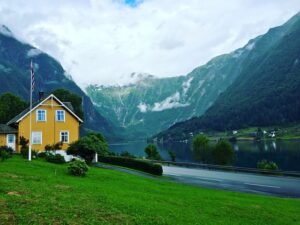

Understanding Norway’s Education System: A Guide for Parents
Norway’s education system is recognized globally for its high standards, inclusivity, and emphasis on holistic development. For parents navigating this system, whether new to Norway or seeking to better understand it, this guide provides a comprehensive overview.
Table of Contents
ToggleStructure of the Norwegian Education System
The Norwegian education system is divided into several stages, each designed to cater to the developmental and educational needs of children at various ages.
Barnehage (Kindergarten)
Aldersgruppe (Age Group): 1 to 5 years
Attendance at barnehage is voluntary, but nearly all children attend. Barnehager are designed to provide a safe and stimulating environment where children can play and learn through activities such as lek (play), tegning (drawing), musikk (music), and historiefortelling (storytelling). The focus is on social skills, basic education, and preparing children for school.
- Foreldresamarbeid (Parent Collaboration): Parents are encouraged to participate in activities and planning.
- Dagsplan (Daily Schedule): Typically includes outdoor play, meals, nap time, and structured activities.
- Satsningsområder (Focus Areas): Emphasizes social interaction, language development, and motor skills.
Grunnskole (Primary and Lower Secondary School)
Aldersgruppe (Age Group): 6 to 16 years
Grunnskole is compulsory and free for all children. It is divided into two main stages:
- Barneskole (Primary School)
- Aldersgruppe (Age Group): 6 to 13 years (Grades 1 to 7)
- Fag (Subjects): Basic subjects include norsk (Norwegian), matematikk (mathematics), naturfag (science), samfunnsfag (social studies), engelsk (English), kroppsøving (physical education), and kunst og håndverk (arts and crafts).
- Læringsmetoder (Learning Methods): Emphasizes interactive and experiential learning, group work, and individual projects.
- Ungdomsskole (Lower Secondary School)
- Aldersgruppe (Age Group): 13 to 16 years (Grades 8 to 10)
- Fag (Subjects): In addition to continuing primary school subjects, students choose valgfag (electives) such as fremmedspråk (foreign languages), mat og helse (food and health), and teknologi (technology).
- Vurdering (Assessment): Introduces formal grading with letters from A to F, with A being the highest. Teachers provide qualitative feedback to help students improve.
Videregående skole (Upper Secondary School)
Aldersgruppe (Age Group): 16 to 19 years
Upper secondary education is also compulsory and free. It prepares students for higher education or vocational training.
- Studieretninger (Study Programs):
- Studiespesialiserende (General Studies): Prepares students for higher education with a focus on academic subjects such as realfag (science subjects), språk (languages), and samfunnsfag (social studies).
- Yrkesfaglig utdanning (Vocational Education): Prepares students for specific trades or professions. Includes practical training in fields like helse- og oppvekstfag (health and social care), teknikk og industriell produksjon (technical and industrial production), and bygg- og anleggsteknikk (construction and building technology).
- Lærlingeordning (Apprenticeship Scheme): In vocational programs, students often spend time as apprentices in companies, gaining hands-on experience.
Høyere utdanning (Higher Education)
Aldersgruppe (Age Group): 19 years and above
Norway offers a range of higher education opportunities through universities and university colleges.
- Gradssystem (Degree System):
- Bachelorgrad (Bachelor’s Degree): Typically three years.
- Mastergrad (Master’s Degree): Additional two years after the bachelor’s.
- Doktorgrad (Doctoral Degree): Usually takes three to four years after a master’s degree.
- Opptakskrav (Admission Requirements): Based on grades from videregående skole and specific entry exams for some programs.
Key Features of Norwegian Education
Inclusive and Equitable
Norwegian schools prioritize inclusion and equity, ensuring all children, regardless of their background, have equal opportunities. The concept of “likhet” (equality) is deeply rooted in the educational philosophy. Schools implement tilpasset opplæring (differentiated instruction) to cater to the individual needs of students. This includes support for students with spesielle behov (special needs) and flerspråklige elever (multilingual students).
Holistic Development
The Norwegian curriculum emphasizes the development of the whole child. This includes physical, emotional, social, and cognitive development. Activities like skolegudstjeneste (school church service) and turer (excursions) are common to enhance students’ cultural and social development.
- Kreativitet og kritisk tenkning (Creativity and Critical Thinking): Encouraged through projects, group work, and discussions.
- Helse og trivsel (Health and Well-being): Physical education and healthy lifestyles are integral parts of the curriculum.
Bilingual Education
Norway has two official written languages: Bokmål and Nynorsk. Schools often teach both, although Bokmål is more commonly used. Additionally, English is introduced early, usually from Grade 1, and is a compulsory subject. In some areas, students also learn samisk (Sami), reflecting the country’s indigenous heritage.
- Språkprogrammer (Language Programs): Programs are designed to support both native speakers and those learning Norwegian as a second language.
Assessment and Grading
In primary school, there is no formal grading. Instead, teachers provide qualitative feedback known as “tilbakemelding”. Formal grades are introduced in ungdomsskole. The grading system uses letters from A to F, with A being the highest and F indicating failure. Teachers also use “kjennetegn på måloppnåelse” (criteria for goal achievement) to describe students’ progress.
- Mappevurdering (Portfolio Assessment): Students compile a portfolio of their work to demonstrate learning progress and achievements.
Parental Involvement
Parental involvement is encouraged in Norwegian schools. Foreldremøter (parent-teacher meetings) are held regularly, and parents are invited to participate in school activities and decisions. Foreldresamarbeid (parent collaboration) is key to ensuring a supportive learning environment.
Communication
Schools communicate with parents through various channels, including written notices, emails, and digital platforms like “Itslearning” or “Skooler”. Learning Norwegian or having a basic understanding of the language can significantly enhance communication and involvement in your child’s education. Regular updates are also provided through ukebrev (weekly letters) or meldingsbok (message book).
- Foreldreutvalg (Parent Committees): Many schools have committees where parents can have a say in school matters.
Vocabulary and Phrases
Here are some useful Norwegian words and phrases for parents navigating the education system:
- Barnehage – Kindergarten
- Grunnskole – Primary and Lower Secondary School
- Barneskole – Primary School
- Ungdomsskole – Lower Secondary School
- Videregående skole – Upper Secondary School
- Høyere utdanning – Higher Education
- Likhet – Equality
- Tilpasset opplæring – Differentiated Instruction
- Foreldremøter – Parent-Teacher Meetings
- Foreldresamarbeid – Parent Collaboration
- Skole – School
- Lærer – Teacher
- Elev – Student
- Lekser – Homework
- Karakterer – Grades
- Fag – Subject
- Prøve – Test/Exam
- Ferie – Vacation/Holiday
- Tegning – Drawing
- Lek – Play
- Norsk – Norwegian
- Matematikk – Mathematics
- Naturfag – Science
- Samfunnsfag – Social Studies
- Fremmedspråk – Foreign Languages
- Kunst og håndverk – Art and Crafts
- Kroppsøving – Physical Education
- Skolegudstjeneste – School Church Service
- Turer – Excursions
- Tilbakemelding – Feedback
- Kjennetegn på måloppnåelse – Criteria for Goal Achievement
- Ukebrev – Weekly Letters
- Meldingsbok – Message Book
- Realfag – Science Subjects
- Språk – Languages
- Samfunnsfag – Social Studies
- Yrkesfaglig utdanning – Vocational Education
- Lærlingeordning – Apprenticeship Scheme
- Spesielle behov – Special Needs
- Flerspråklige elever – Multilingual Students
- Kreativitet og kritisk tenkning – Creativity and Critical Thinking
- Helse og trivsel – Health and Well-being
- Språkprogrammer – Language Programs
- Mappevurdering – Portfolio Assessment
- Foreldreutvalg – Parent Committees
Example Sentences
- “Mitt barn går i barnehage.” – My child goes to kindergarten.
- “Når er foreldremøtet?” – When is the parent-teacher meeting?
- “Hvordan går det med leksene?” – How is the homework going?
- “Kan du hjelpe meg med å forstå karakterene?” – Can you help me understand the grades?
- “Skolen bruker Itslearning for kommunikasjon.” – The school uses Itslearning for communication.
- “Hva er planen for sommerferie?” – What is the plan for summer vacation?
- “Min sønn har en prøve i matematikk i morgen.” – My son has a math test tomorrow.
- “Det er viktig med foreldresamarbeid for barnas beste.” – It is important with parent collaboration for the children’s best.
- “Vi har fått tilbakemelding på barnets utvikling.” – We have received feedback on the child’s development.
- “Hun liker veldig godt kunst og håndverk.” – She really likes art and crafts.
- “Skolen arrangerer en tur til museet neste uke.” – The school is organizing a trip to the museum next week.
- “Tilpasset opplæring er viktig for inkludering.” – Differentiated instruction is important for inclusion.
- “Kreativitet og kritisk tenkning er sentralt i læreplanen.” – Creativity and critical thinking are central in the curriculum.
Sample Dialogues
Dialogue 1: Parent-Teacher Meeting
Forelder (Parent): “Hei, jeg heter Maria og er moren til Jakob. Takk for at du kunne møte meg i dag.” Lærer (Teacher): “Hei Maria, hyggelig å møte deg. Hvordan kan jeg hjelpe deg i dag?” Forelder (Parent): “Jeg er litt bekymret for Jakobs prestasjoner i matematikk. Kan du fortelle meg hvordan han gjør det?” Lærer (Teacher): “Selvfølgelig. Jakob har forbedret seg mye, men han trenger fortsatt litt ekstra hjelp med algebra. Vi jobber med tilpasset opplæring for å hjelpe ham.” Forelder (Parent): “Det er godt å høre. Hvordan kan jeg hjelpe ham hjemme?” Lærer (Teacher): “Du kan hjelpe ham med lekser og kanskje bruke noen online ressurser. Jeg kan sende deg noen lenker etter møtet.”
Dialogue 2: Discussing Homework
Forelder (Parent): “Hei, Mia. Hvordan går det med leksene i dag?” Barn (Child): “Det går bra, mamma. Jeg har litt norsk og matematikk igjen.” Forelder (Parent): “Trenger du hjelp med noe av det?” Barn (Child): “Kanskje med matematikk. Jeg forstår ikke denne oppgaven.” Forelder (Parent): “La oss se på det sammen. Vi kan finne ut av det.”
Dialogue 3: Communicating with School Administration
Forelder (Parent): “Hei, jeg er her for å snakke med rektor om skolens nye teknologi program.” Administrasjon (Administration): “Hei, velkommen. Rektor er på kontoret sitt. Hva heter du og hva gjelder det?” Forelder (Parent): “Jeg heter Lars, og jeg har noen spørsmål om hvordan programmet vil påvirke elevenes læring.” Administrasjon (Administration): “Selvfølgelig, Lars. Rektor vil gjerne snakke med deg. Vennligst vent et øyeblikk.”
Conclusion
Understanding Norway’s education system is crucial for parents to support their children’s academic journey effectively. The system is designed to be inclusive, equitable, and focused on holistic development, ensuring every child receives a well-rounded education. By familiarizing yourself with key aspects and common Norwegian educational terms, you can better engage with and support your child’s learning experience in Norway. Active participation and communication with teachers and school administration will enhance your involvement and positively impact your child’s educational experience.
If you want to learn Norwegian, you can register for classes here. We look forward to hearing from you and helping you become fluent in Norwegian.





